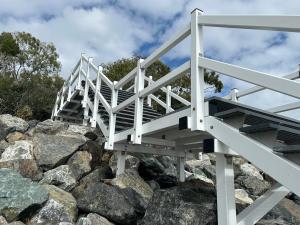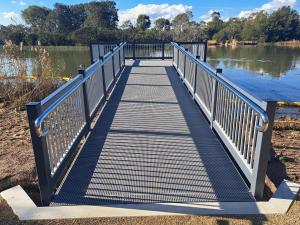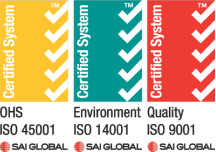a blog by Wagners CFT, SA/WA/NT Business Development Manager, Robbie Westley (Connect via LinkedIn)
When it comes to Fibre Reinforced Polymer (FRP) structural profiles, durability is everything. Customers choose FRP over traditional materials like steel, aluminium, or timber because it offers long design life, corrosion resistance, and low maintenance. But there is one universal challenge every FRP manufacturer must address: ultraviolet (UV) degradation.
UV exposure slowly breaks down the resin system in FRP and left unchecked can cause fading, fibre blooming, surface chalking, and, in extreme cases, reduction of mechanical performance over time. Many FRP manufacturers try to mitigate this problem by adding UV inhibitors into the resin during the pultrusion process. While this approach has some short-term benefits, it doesn’t provide the long-term surface protection that critical infrastructure demands.
That’s why Wagners Composite Fibre Technologies (CFT) takes a different approach. Instead of relying only on UV inhibitors within the resin, Wagners CFT cover their FRP pultruded structural profiles with either a fluoropolymer or polyurethane coating. This may seem like an additional step, but it is a deliberate and highly engineered decision that offers significant advantages in real-world applications especially here in Australia where FRP structures experience some of the harshest UV conditions on the planet.
Let’s unpack why.
The Limits of UV Inhibitors in FRP
During pultrusion, resins can be mixed with additives such as UV absorbers or stabilisers. These work by absorbing or reflecting a portion of the UV radiation, slowing the degradation process. On paper, this sounds like a possible solution, but why not stop UV damage before it starts?
The reality is that UV inhibitors have finite capacity. They degrade over time themselves, meaning their protective effect diminishes with prolonged exposure. In harsh Australian conditions, with intense sunlight and high UV index, inhibitors can lose effectiveness within years. Once that happens, the underlying resin is exposed directly to UV, and degradation accelerates.
There’s also the issue of distribution. Evenly dispersing inhibitors through the resin doesn’t guarantee that the exposed surface (the part that actually interacts with UV), is fully protected. Once the surface layer begins to wear, inhibitors deeper within the resin are irrelevant, because they never see sunlight.
In short: while UV inhibitors are helpful, they are not a permanent or a sufficient solution for infrastructure expected to last 50 to 100 years.

Urangan Pier FRP beach access stairs, near Hervey Bay in Queensland
Lessons from Experience: Why Wagners CFT Changed Its Approach
More than 20 years ago, Wagners CFT also relied solely on UV inhibitors within the resin system to protect its FRP structural profiles. At the time, this was considered best practice. However, after several years of real-world exposure, particularly in Queensland’s extreme UV conditions, the results spoke for themselves. Surface fading, fibre bloom, and chalking occurred far sooner than expected.
The Australian sun proved that UV inhibitors alone were no match for local conditions. That experience drove a major shift in Wagners’ manufacturing philosophy, from relying on internal inhibitors to adopting external coatings as a complete UV-blocking system. By fully coating their structural profiles, Wagners CFT eliminated UV exposure to the resin altogether, dramatically improving long-term performance and appearance in even the harshest environments.
Why Paint Provides Superior UV Protection
Painting FRP is more than a cosmetic choice, it’s a protective system. Wagners CFT applies a specifically developed coating to their FRP pultruded profiles that acts as a durable, sacrificial barrier between the environment and the resin matrix.
This brings several key advantages:
- Physical Shielding: Paint forms an opaque barrier that prevents UV rays from reaching the resin at all. Instead of trying to absorb or dissipate radiation within the FRP, the coating blocks it outright.
- Renewable Surface Protection: Unlike impregnated inhibitors that degrade irreversibly, paint coatings can be reapplied or touched up. This extends the design life of the product without compromising structural integrity.
- Resistance to Surface Blooming: Without paint, UV degradation can cause fibres near the surface to become exposed, leading to a rough, unattractive finish that if in contact with skin can cause micro abrasions and skin irritation including itching and redness. Painted FRP maintains its smooth, clean surface.
Enhanced Aesthetic and Design Flexibility
One of the often-overlooked benefits of painting FRP profiles is aesthetic control. While raw FRP can be functional, it is not always visually appealing, particularly after years of UV exposure. For public-facing infrastructure like bridges, walkways, utility poles, or architectural elements, appearance matters.
Paint ensures colour stability over time and allows designers, asset owners, and engineers to specify profiles that complement their environment. For example:
- Transport and utility applications: High-visibility yellows, oranges, or reflective finishes can improve safety and compliance.
- Boardwalks and pedestrian bridges: Neutral or earthy colours help infrastructure blend seamlessly into sensitive natural settings.
- Industrial applications: Custom corporate colours can be applied to maintain brand consistency.
Without painting, these options aren’t available as resin pigmentation alone can’t achieve the same depth, consistency, or longevity of colour.

Jells Park FRP viewing platform near Wheelers Hill in Victoria
Lifecycle Cost Benefits
At first glance, some may argue that painting adds cost compared to relying solely on inhibitors. However, Wagners CFT’s approach is based on whole-of-life economics, not just upfront savings.
Unpainted FRP with inhibitors may look acceptable for a few years, but once surface degradation begins, asset owners face difficult decisions including accepting a deteriorated appearance, attempting costly repairs, or replacing components earlier than expected. All of these increase long-term costs.
Painted FRP, by contrast, delivers predictable performance. The protective coating extends the service life of the profile and can be easily refreshed if required, without replacing the underlying structure. The upfront investment in painting is far outweighed by savings in avoided maintenance and replacement over the structure’s lifecycle.
Proven Performance in Harsh Conditions
Wagners CFT doesn’t take shortcuts when it comes to performance. Their painted FRP profiles have been proven in some of the most demanding environments in Australia and internationally:
- Marine boardwalks and bridges, where UV exposure combines with salt spray and moisture.
- Utility infrastructure, where long spans of poles or crossarms face decades of outdoor service without replacement.
- Industrial sites, where chemical exposure and abrasive conditions demand robust surface protection.
These case studies demonstrate that painting isn’t just theoretical—it has been validated in real projects that continue to perform today.
Check out Wagners CFT projects from around the globe at the following link https://www.wagnerscft.com.au/projects/
The Sustainability Perspective
In the current climate, sustainability is a decisive factor in material choice. FRP already has a strong environmental story; being lightweight, corrosion-resistant, and with a long service life, it reduces the need for frequent replacement compared to steel or timber.
By painting profiles rather than relying solely on inhibitors, Wagners CFT further improves sustainability outcomes. How?
- Longer design life = fewer replacements. Each replacement avoided prevents significant embodied carbon from new production, transport, and installation.
- Surface repainting = less waste. Instead of scrapping entire components, only the paint layer is renewed.
- Visual longevity = community acceptance. Assets that remain attractive are less likely to face premature replacement due to aesthetic concerns.

Wattle Track FRP pedestrian bridge in Dandenong Ranges National Park, Victoria
Why Wagners CFT Chooses Paint Over Shortcuts
Ultimately, the decision comes down to Wagners CFT’s philosophy as a manufacturer. Wagners CFT isn’t interested in delivering the minimum performance that looks good for a few years. Their mission is to provide structural profiles that genuinely deliver a 100-year design life.
Relying solely on UV inhibitors would compromise that goal. It may work in the short term, but it doesn’t provide the certainty, durability, and flexibility that asset owners need for infrastructure investments. Painting does.
Conclusion: A Protective System, Not Just a Product
FRP is a remarkable material, but like any engineered solution, its performance depends on the details of design and manufacture. UV degradation is an unavoidable reality, but how manufacturers respond to it separates leaders from followers.
Some businesses take the easy route, impregnating resin with UV inhibitors and marketing their products as “UV-resistant.” While that may sound convincing to an untrained ear, it doesn’t guarantee long-term performance. Asset owners who don’t look deeper may find themselves dealing with premature surface degradation, unexpected maintenance, and higher lifecycle costs.
Wagners CFT takes a different approach. By painting their FRP pultruded structural profiles, they provide a true protective system that delivers superior UV protection, renewability, design flexibility, and lifecycle value.
It’s not just about colour. It’s about confidence. Confidence that the structure you install today will still be performing—and looking good—decades into the future.
Watch the webinar with Ben Gillies from A&I Coatings on FRP Coating: What’s in it & why? https://www.wagnerscft.com.au/webinars/frp-coating/ Or read the article on ‘Why Wagners Choose A&I Fluoropolymer Coating for It’s FRP Profiles’ https://www.wagnerscft.com.au/why-wagners-choose-ai-fluoropolymer-coating-for-its-frp-profiles/
Join Wagners CFT Chief Technical Officer Michael Kemp for this on demand webinar as he explores It’s What’s Inside That Counts with FRP structural profiles https://www.wagnerscft.com.au/webinars/its-whats-inside-that-counts/ or read the article https://www.wagnerscft.com.au/its-whats-inside-that-counts/


